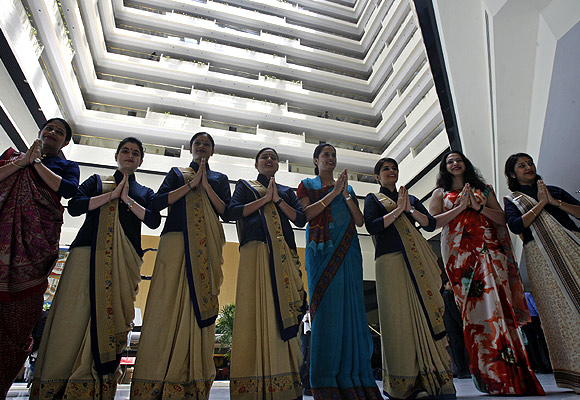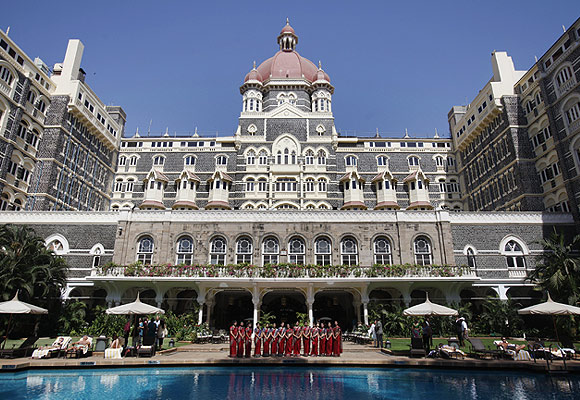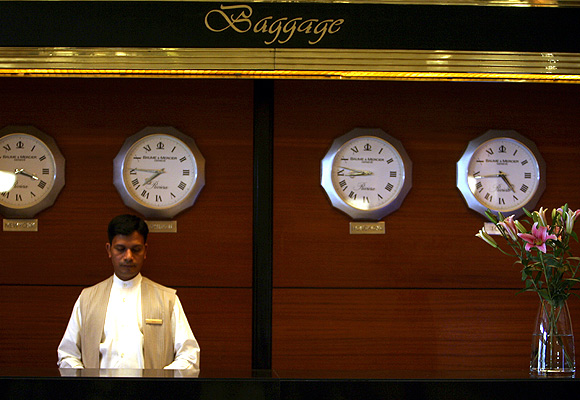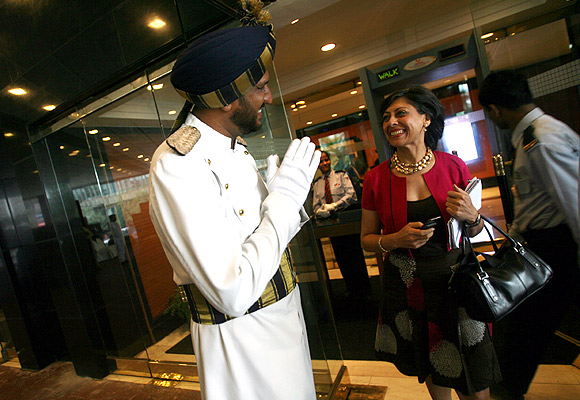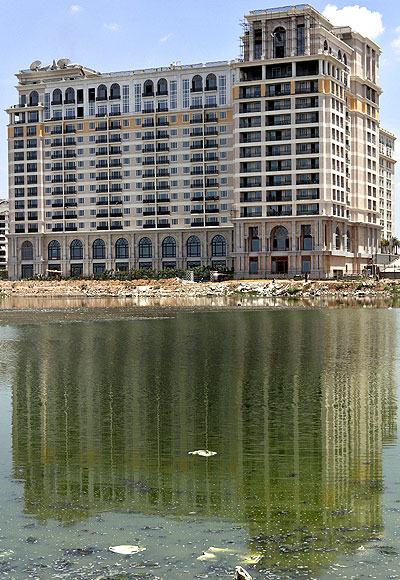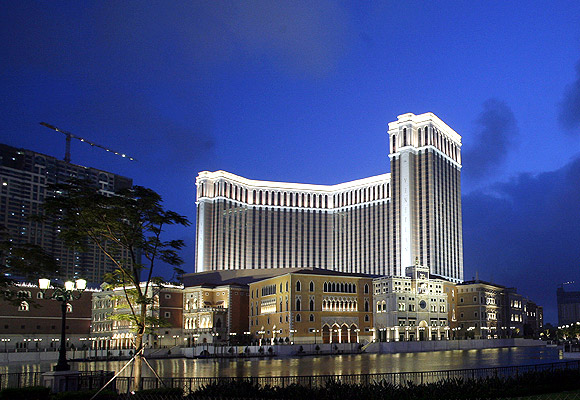 | « Back to article | Print this article |
Why hotel stocks are underperforming
Business travellers are known to be demanding. They kick up a fuss if the services are even slightly slipshod. Hotel chains, therefore, go to great lengths to fulfil their whims and fancies-no matter how excessive.
However, they are falling short on their promises when it comes to meeting the expectations of their shareholders.
The hotel industry has been the biggest under-performer on the bourses in the last five years.
The combined market capitalisation of the top seven listed companies, including Indian Hotels Company, East India Hotels, Hotel Leelaventure and Taj GVK, a joint venture between Indian Hotels and Hyderabad-based GVK group, is a third of its peak of December 2007, despite the Sensex scaling new heights during the period.
The future looks no better, even though the stock market overall seems poised for a party.
Click NEXT to read more...
Why hotel stocks are underperforming
Experts attribute the industry's woes to the fast-paced growth of recent years.
"The hotel industry in India is among the fastest growing in the world. Nearly 60 per cent of the hotels in the country are less than five years old. Most of them are making operating profit but it will take many more years to recover the fixed cost. This show ups in their financial ratios which the stock market doesn't like," says Kaushik Vardharajan, managing director of HVS Global Hospitality Services (South Asia), a consultancy firm.
The boom in new properties is evident in the balance sheet of the companies.
In the ten years to FY12, the gross block (cumulative investment in properties and equipment) of the top seven listed companies has quadrupled to Rs 17,000 crore (Rs 170 billion), and it is growing at a compounded annual rate of 14.1 per cent.
The inventory of rooms during the same period grew even faster as many hotel chains, especially foreign brands such as Marriott and Starwood, took the management-contract route to growth where high-networth individuals and builders invest in properties.
Click NEXT to read more...
Why hotel stocks are underperforming
For Hotel Leelaventures, gross block jumped seven times during the period-a growth rate of 22 per cent annually. In contrast, Indian Hotels-the market leader-was more conservative, increasing its fixed investment at CAGR of 13.5 per cent.
The EIH group, which owns and operates Oberoi and Trident chain of hotels, has been the most conservative.
The combined gross block of the group's two listed companies-EIH and EIH Associated Hotels- grew at a CAGR of 8.6 per cent in the last decade, at half the industry rate.
Too many rooms
However, the industry is now being slowed by its own growth story. "Hotel is a cyclical industry and demand growth is closely linked to GDP growth. When the economy is doing well, everyone wants to make a hotel. This leads to oversupply followed by a drought," says Sudeep Jain, executive vice-president (hotels and hospitality) at Jones Lang LaSalle, an advisory firm.
According to him, most of the projects planned during the boom years of 2007 and 2008 are now hitting the market, leading to a supply overhang. This in turn has put downward pressure on occupancies and average room rates (ARR).
Click NEXT to read more...
Why hotel stocks are underperforming
According to HVS, the demand grew fastest during the boom years preceding the 2008 financial crisis but bulk of the new supply came after 2008 and coincided with the slowdown.
Between FY02 and FY07, demand for rooms grew at 13.5 per cent annually. Since then, growth has moderated to 10 per cent.
In contrast, supply has grown at a CAGR of 15 per cent in the five years to FY12, more than two- and-half times the pace in the previous decade.
Obviously, the mismatch has taken a toll on occupancies and room rates. The average occupancy in the industry fell from 71.5 per cent in FY06 to 59.1 per cent in FY12.
The average room rate for a five-star deluxe room was down to Rs 9,192 in FY12 from Rs 11,200 per night in FY08. With inflation in double digits, for the hotels it has meant low profit margins and poor return ratios.
Click NEXT to read more...
Why hotel stocks are underperforming
However, not everyone is convinced the current woes of the industry are merely cyclical. Many experts say hoteliers courted financial trouble by over-investing in properties.
"There is a certain aspiration and glamour around hotels, especially in the high-end luxury segment, and many developers get in the race to build grand properties rather than one that will give them the best financial return. For them, RoE means return on ego rather than return on equity," says an analyst who does not want to be named.
A case in point is the Leela Palace hotel in New Delhi. Opened in 2011, the 260-room property is the country's costliest hotel project with an investment of nearly Rs 2,000 crore, half of which went into acquiring the plot on which it stands.
Even excluding the land cost, project cost per room is nearly three times the industry benchmark for a luxury property. In FY12, the development cost of a typical luxury hotel was Rs 1.78 crore (Rs 17.8 million) per room, according to a survey by HVS.
To recover this high investment, room rates at Leela should be at least three times what its competitors charge in the same category.
Click NEXT to read more...
Why hotel stocks are underperforming
This is difficult as room rates are determined by the demand-supply dynamics and there is only so much that a hotel can charge for its premium services. Obviously, the grand project has been a financial disaster for its promoter, Hotel Leelaventure.
At the end of FY12, it was struggling with a debt-to-equity ratio of 2.62 and has now turned loss-making as interest on the debt is more than its operating margins. Hotel Leelaventures refused to participate in the story.
Costly buys
Experts say some hotels also showed excessive enthusiasm in pursuing acquisitions which have now turned their finances upside down.
For instance, Indian Hotels' acquisition of 11 per cent stake in Oriental Express Hotels at an average price of $42 per share in 2007 is now worth a quarter.
The company also acquired a series of properties in the US and the UK, most of which are still to yield returns.
Click NEXT to read more...
Why hotel stocks are underperforming
Another challenge for home-grown chains such as Taj, Oberoi, ITC and Leela is the increasing footprint of foreign brands through management contracts with local builders and high net worth individuals.
This has tilted the scale against Indian chains who still believe in putting their own money in the business.
"The operator model eliminates the financial risk to foreign chains but provides them all the upside from the country's growth story. This has enabled foreign chains to scale-up faster," says Sudeep of JLL. International chains such as Marriott, Starwood, Hilton and Hyatt charge 9 to 12 per cent of the revenues as management fee.
There are many, however, who are sceptical of the long-term viability of the operator-only model.
"Foreign chains have grown faster but their presence is still limited to the mid-market segment where project sizes are small. Upscale and luxury is still dominated by Indian companies and foreign brands have begun to realise that investing their own money is the fastest way to grow in India," says Kaushik.
Click NEXT to read more...
Why hotel stocks are underperforming
This explains why the current market leader, Indian Hotels Company (IHC), is following a hybrid investment strategy. The Tata company is investing in flagship properties in top cities and entering into management contracts at other centres.
"Indian Hotels is attacking the feeder markets both in India and outside by having its own property at key destinations and then scaling up its brand presence by entering into management contracts with developers at other locations. This keeps its fixed costs to minimum without the fear of losing control of the network," says Apurva Prasad, equity research analyst at ITI Securities.
Nearly two-thirds of all planned expansion by IHC is under management contract.
Caught in the slowdown, the industry is now also moving towards the mid-market and affordable segment to boost revenues. The trend has been driven by the rising share of domestic travellers.
Click NEXT to read more...
Why hotel stocks are underperforming
"Five-star luxury hotels were built for foreign travellers but domestic travellers now outnumber them and this trend will only strengthen with time. Budget hotels are the themes of tomorrow and hotel companies will need to tweak their portfolio to participate in the growth," says Revati Kasture, head of research at Care Ratings.
Industry executives compare this with the evolution of the car industry. "Just like car companies have models at various price points to tap different consumers, the same is happening in our industry now," says P K Mohankumar, managing director and CEO, Roots Corporation, which owns and manages the Ginger range of budget hotels.
Many companies are restructuring their brand portfolio to tap the middle class. Three years ago, the Taj group reorganised its entire portfolio under four distinct brands each targeted at a particular market segment.
While Taj sits at the top, Gateway and Ginger are for budget-conscious travellers and in the middle sits Vivanta by Taj.

